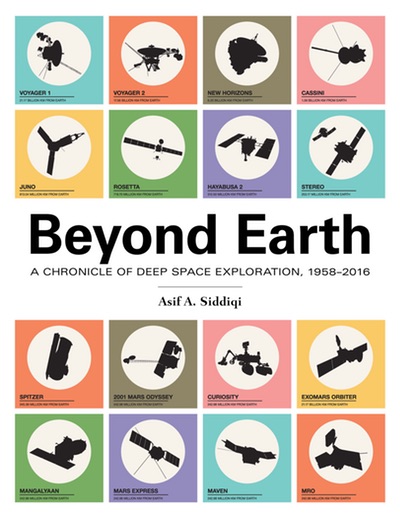Review: Beyond Earthby Jeff Foust
|
| AN instryment designed to look for life on Mars was removed from an early Soviet mission shortly before launch. “A possibly apocryphal story has it that once removed from the spacecraft, the spectroreflectometer was tested not far from the Tyuratam launch site but failed to detect any life.” |
The book is a compilation of every “deep space” mission launched from the beginning of the Space Age, through late 2016, organized in chronological order of launch date, from Pioneer 0 in 1958 through OSIRIS-REx in September 2016. Siddiqi takes a broad view of what should be included in that description, from missions to the Moon or other solar system bodies to spacecraft flown into heliocentric orbits or Lagrange points. “The criteria for inclusion here is simply whether the mission was intended to operate beyond Earth orbit,” he writes, regardless of the science being done or the technology being demonstrated.
Each summary includes basic statistics about the mission—spacecraft mass, launch date and vehicle, complement of scientific instruments—and a summary of the mission. Those summaries can run from a few sentences for early, failed missions (particularly Soviet ones about which little is known) to several pages of text and images. The summaries are written in a just-the-facts format: no analysis or commentary about the missions, but instead a factual summary of how the spacecraft were developed and operated, and what they achieved (or failed to achieve.) That approach does get a little strained, though, on the longer mission summaries, which span several pages but are in the form of a single paragraph.
While the book is focused on overviews of missions, there are plenty of interesting notes about the various missions even for those familiar with many of them. The entry for an early Soviet Mars mission, Mars 1M no. 1, notes the spacecraft was supposed to carry a spectroreflectometer to detect the presence of organic materials, but was removed from the spacecraft shortly before launch because of mass constraints. “A possibly apocryphal story has it that once removed from the spacecraft, the spectroreflectometer was tested not far from the Tyuratam launch site but failed to detect any life,” Siddiqi notes. Tortoises carried on the Zond 5 mission, which flew around the Moon before returning to Earth, were dissected after arrival. “The results of dissection, performed on 11 October [1968] after ‘a 39-day fast,’ showed that ‘the main structural changes in the tortoises were caused by starvation’ rather than flight to lunar distance or the subsequent travel back from the Indian Ocean to Moscow.”
Beyond Earth is a good reference work for anyone interested in the history of deep space missions, and with the books freely available, there’s little reason not to download a copy. (The book does include a number of tables of missions in the back; these look best in the PDF version rather than the two ebook formats also offered.) It is, though, already out of date in some respects: its last updates were in mid-2017 when Siddiqi completed the book, and there have been a variety of developments in the more than 12 months since. Maybe that’s the surest sign of whether or not we’re in golden age of space exploration.
Note: we are temporarily moderating all comments subcommitted to deal with a surge in spam.
